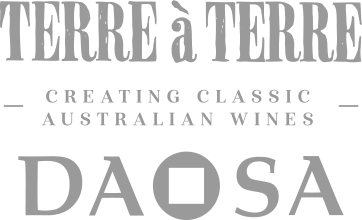CRAYÈRES VINEYARD – WRATTONBULLY
The 2017 vintage was a surprisingly long wait. Late flowering led to late véraison and thus a late harvest. However, this is not to say that 2017 was a cool vintage; in fact it was warmer than average but without any heatwaves. It was also quite humid at times, however beneficial winds always came with the rain. In the end, our unique closed-spaced Crayères vineyard in Wrattonbully tested the patience of the Vigneron, but this patience was rewarded as it delivered some of the best fruit we have yet seen from this vineyard.
Climate
The 2017 growing season was warm and moderately humid, and started after one of the wettest winters we have seen in the vineyard since we planted it. Good flowering conditions under favourable skies led to late but very successful fruit set. Wet conditions favoured vigorous shoot growth and we had to implement severe shoot thinning to keep the canopy open. The excellent flowering and fruit set meant we had lots of bunches per vine and lots of berries per bunch and we had to do a severe and timely green harvest before véraison to keep the yields under control. Véraison occurred later than average (around 15 February) and happened quickly for all varieties.
The Crayères vineyard did not experience any severe heatwaves in 2016/17, and the fruit ripening occurred under sunshine with a couple of big rain events. The open canopy and good fruit spread meant that we did not get any disease outburst in any of the varieties.
For the second time we collected data from the weather station in the Crayères vineyard. It shows 1,562 degree days from October 2016 to April 2017, which is slightly warmer than long term average, and 228mm of rain which is higher than average. It was a challenging growing season because it was late and because of the rain events. However, the fruit that was picked was superb and 100% clean for all varieties.
Harvest
Sauvignon Blanc
We handpicked our Sauvignon Blanc very ripe and with 0% Botrytis/mould on the 22nd and 23rd of March 2017, so one month after 2016! The grapes were picked on flavour. For the Crayères vineyard cuvée, the fruit was chilled to 3°C for whole bunch pressing, and fermented in demi-muids. For the Down to Earth cuvée, part of the fruit was whole bunch pressed and fermented in 2 large 2,000L and 3,000L oak foudre in a temperature controlled cellar with the balance of the fruit being crushed, destemmed, and then fermented in stainless steel at even lower temperatures.
Shiraz
We handpicked perfectly ripe and clean (0% Botrytis/mould) Shiraz on the 10th of April 2017, so 25 days later than 2016. We had yields of 8.5 tonnes per hectare, after thinning twice before véraison to get the right yields. The Shiraz was fermented in 1 Potter fermenter with boards keeping the cap submerged. After 1 full month of cold maceration, fermentation and post fermentation maceration, it has now been pressed off skins and transferred to French oak barrels (30% new). At this stage of its life it looks like it will be a classic Shiraz from this part of Australia, in line with the Shiraz from Great Western / Pyrennees.
Cabernet Franc
The Cabernet Franc came off the day after the Shiraz, on the 11th of April 2017. The yields were excellent at 8.5 tonnes per hectare and the fruit was perfectly ripe and free from any disease. The Cabernet Franc was all fermented in 1 Potter fermenter with boards keeping the cap submerged (except the board broke half way through fermentation – we had to cycle and pump the juice). We pressed off skins after 25 days of cold maceration, fermentation and post fermentation maceration. It was racked to French oak barrels (15% new).
Cabernet Sauvignon
On the 19th of April 2017 we handpicked our close-spaced Cabernet Sauvignon. With good yields of 9 tonnes per hectare, the fruit was perfectly ripe at harvest and completely free from disease. The must was fermented in 1 Potter fermenter with boards to keep the cap submerged (cycled only once during vintage) and 3 one-tonne fermenters. The wine was pressed off skins after 35 days of maceration and fermentation and left to settle in a tank for 12 days before being racked to 30% new French oak barrels. It will be a classic example of Limestone Coast Cabernet Sauvignon.
Epilogue
Every year we leave 3-4 tonnes of ripe Sauvignon Blanc (free from disease) on the end rows with the hope they will get infected by Botrytis noble rot. This year, we had rain late April, after we finished picking all our reds, and Botrytis decided to invade simultaneously all of the remaining Sauvignon Blanc bunches. We harvested fully botrytised bunches on the 9th of May 2017, and the juice is now fermenting in tank. Wait and see!
BIZOT VINEYARD AND SUMMERTOWN VINEYARD – PICCADILLY VALLEY
Our two vineyards in Piccadilly Valley produced very fine sparkling base Pinot Noir and Chardonnay fruit and also classic and highly perfumed table Pinot Noir in 2017.
Climate
The 2017 growing season in the Piccadilly Valley was slightly warmer than average at around 1,350 degree days compared to the 12 year average of 1,235 degree days. Rain was frequent and helped to maintain vine health (no irrigation required in 2017).
Harvest
Summertown vineyard
2017 was the second vintage of the Summertown vineyard under our care. The part of the Pinot Noir block that was retrellised in 2016 to convert from spur pruning to cane pruning produced very good fruit this year. The canopy grew moderately and needed a very light trimming. The sparkling base Chardonnay and Pinot Noir blocks did not require bunch thinning and were carefully hand harvested on the 28th of March 2017, so exactly one month later than in 2016, with reasonable yields of 12 tonnes per hectare for sparkling. The base wine is now finishing fermentation in tanks and will go into our second Pinot Chardonnay cuvée for Daosa.
The table Pinot Noir blocks were bunch thinned to get to yields of 6 tonnes per hectare. They were hand harvested on the 15th of April, so well over a month later than 2016, to get as much ripeness in the Pinot berries as possible. They were fermented in 1-tonne fermenters, and are now ageing in French oak barrels (40% new, 60% old oak).
Bizot vineyard
The Chardonnay for our Daosa Blanc de Blancs was hand harvested on the 25th of April 2017. The fruit displayed great acidity at harvest with elegant flavours, and the wine is now going through malolactic in old French oak demi-muids (600L).
CONCLUSION
2017 was a late and warm vintage… surprisingly so. It seems like the vines woke up late from dormancy and decided to take it easy after the exhausting sprint of 2016. We tended to our trekking vines as best we could, making sure they did not have to carry too much canopy and too many grapes on their journey. We are very happy to see the end result and can’t wait to release the resulting wines!



